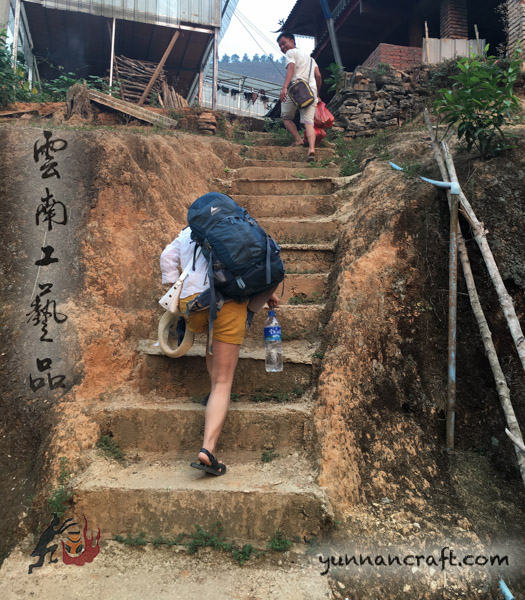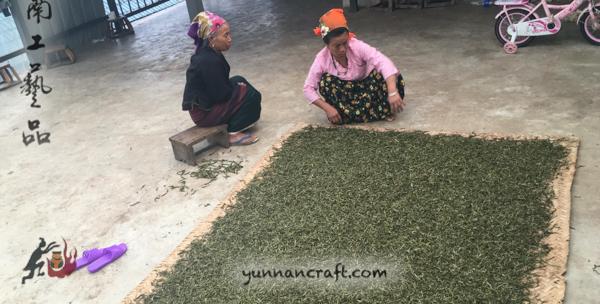Arriving to steamy hot Jinghong late afternoon. The temperature still holds over 30C which is rather pleasant. Yet next day the barometer hits almost 40C and there is no fun being outside more than 1hour. Trying to figure out how to run into the mountains asap to escape this sauna. Menghai is bit cooler but still not really pleasant during the day when walking around local tea shops.

Still we have to do some walk around and see what’s new on the market coming down from surrounding mountains and taste some 2019 spring mao cha before hit the road up to the hills. Every year the Menghai layout gets upgraded. New shops, new apartment blocks , buildings . Some restaurants close some open , but this year , as we also learn from the boss of our hotel , that not many regulars ( tea biz people ) has showed up.
Yes, the dry season. This year is quite bad for tea . Too little and too expensive of course. As we learn from our friend who has tea shop in Jing Hong, that this year instead of buying 100kg of this and 200kg of that, he only could get 10kg or 20kg of some teas. Is some cases even purchased 5kg of Gu Shu on pre-order for his regular customer. So instead of buying a ton of tea, could get hardly 100kg , but almost for the same price…as he sarcastically noted 😉
The positive thing about Menghai these days is that many shop owners are actually the farmers or tea producers, not just vendors like in Kunming or other places. Usually their children or family members are looking after the shop so we getting hands on this year’s Hua Zhu Liang Zi. The excessive bitterness with aggressive hui gan please those who love powerful tea with jaw screaming “ba qi” , but the price is not pleasant at all.



Of course that the rent of the shop costs something and farmers are not investing money into the direct sourcing just to please tea drinkers with lower prices with concept ” skip the middleman – get it cheaper” , but we do not feel that the tag is equivalent to what is in the cup. Randomly trying many other fresh shengs and slowly getting familiar with threshold prices of the this year’s mao cha , at least in Menghai. The bottom line has definitely gone up despite the quality stays the same or even worse.
Due to the small harvest issue , the overall grade of mao cha also decreased. Most of them were not selected out of the “huang pian ” yellow leafs , yet sold as higher grade with words ” ooh, yes, there are some huang pian there, not much” . Longer stems and lower grade ratio of tips:leafs reminding last trip to Mang Fei ( also in our blog ).

Next day heading to the mountains. This year we aim on Bu Lang Shan. Meeting with young tea farmer who bring us to his village and letting us try his 2019 Bulang sheng puerh coming from the old tea trees growing right behind the house. We are impressed with the thick and bitter ( typical for Bulang ) tea liquor and sweet olive hui gan after few cups. Yet, same story with the price.





He honestly told us that he also doesn’t think that this year tea not worth the commanded prices pointing on the blue roofs of the houses in the village. We learn for what prices Gu Shu has been sold to Cantonese tea businessmen who come over apparently to buy their tea because very close to Lao Man E in taste and so they re-sell it back in Guangzhou for the equivalent price. We do not bother much if the story is true or just little trick how to lure in customers on impression of higher ranking tea , since the asking price is very off what our clientele is willing to purchase.





Walking around the village I can see that business is still doing well. Quite few new houses just being built from the foundations, some of them repaired or extended. In first look very quite small village, but after roaming a bit , realizing that local economy is not so bad ( comparing to other places we have been to ) .
The new , more convenient , road also has been built to the village for easier access , which boosted their traffic for tea. Local Mayor seem to be very active in tea business and organizing various projects for supporting local tea farmers , including Yan’s family ( our farmer ) .
Unfortunately , as it is also common in such places , dealing with the plastic garbage is the last thing they worry about. These issues worry many small villages like this , yet even those with better economy do not feel it is their responsible to deal with it.


It does take some investment into the waste management and bring the garbage to the recycling location , which could be quite far and for many villages not affordable. Yet, Yan has managed to buy him self a brand new SUV car , so the things can not be that bad here alright. It is hard to judge if those people are actually in need , based on their house or clothes , since no matter how much money they would have in account, these things would stay the same.
Yan is driving us down in to the lower part of the mountains to visit his house where he lives with young wife and mother in law. This village looks more “real” , not much developed , authentic place with very little to offer to such a hyped tea tourism. Small arbors and bush tea plantations located on the west slope of the mountain , which is hardly to be harvested for some big tea business purposes.





Of course we try their tea as well. Yan’s wife is working hard all day long with other women in the village ( as it’s common in their culture ) . She fried few woks of fresh tea leafs , cooked dinner for us, gave a shower to their daughter then do the “rou nian” to roasted tea leafs after , while he was relaxing with his phone and calling up some friends who later arrived later.







As it’s usual in such a places, nice dinner , lots of drink , music played on local instrument. As we learn later , not many local people are actually willing to try to find some other day job in Menghai. In other villages some tea farmers have also regular whole year job and going back to village only for the harvest season. That’s the best way to keep family income above the critical level and get some bonus in spring with autumn. Many of the Bulang people rather bet on tea business which requires only few months actual work and therefore the tea price comes from availability rather than quality. Similar concept we have witnessed in Yiwu, where some farmers call the price after full harvest is done / processed. Then based on desired half year ( till next harvest ) income, the price is set.


It is hard to judge, since we don’t live there all year long to know the overall situation and I can imagine the work opportunities in places like Menghai must be very limited, yet seeing dry soil on slopes full of the Gu Shu growing just right behind the house with water supply from local stream and hearing farmers “crying” about the dry weather – therefore increased prices of mao cha instead of going and bring some buckets of water or simply pull the hose out.

If your source of living ( tea trees ) are dying , you would better to do something about it. Especially tea trees with such a value. This is not a first place where we are getting an impression, that local people just taking that for granted and expect that everything will be done it self somehow…or at least they think it should be.

Going back to Jing Hong with few bags of “left overs” from spring harvest without any disappointment ( as we expected already such a result ) , but with good lesson. We do not position our selves as big tea business company with large amount purchase , yet not as just some tea tourists who would just follow the path made by the tea farmers aiming on overpriced retail concept.
